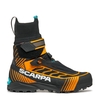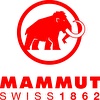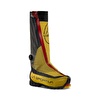Johnny Dawes - the rock climbing interview

 1 / 3
1 / 3 Dave Brown
Dave Brown
Eloquent, articulated. Talented. Artistic. Self-assured. These are the words that immediately spring to mind after speaking to Johnny Dawes, without a shadow of doubt one of the most talented and influential British rock climbers of all times. Born in 1964, Dawes took up climbing aged 14. At the time British climbing was all trad and pegs - guided by the likes of Pete Livesy and Ron Fawcett and was being revolutionised by the advent of bolts, powered by Ben Moon and Jerry Moffatt and driven by Andy Pollit, John Redhead, Paul Pritchard, John Dunne, Steve Mayers to name but a handful of the most important. It was in this context that throughout the mid '80's and early '90's Dawes came into his own, creating with his hallmark creative genius a nigh endless list of testpieces which took British trad climbing into a hitherto unimaginable realm, both in terms of sheer difficulty and style in which they were climbed.
Dawes' routes spanned the width and breadth of Britain's rock, from Gogarth sea cliffs to Llanberis slate, via the Scottish and Welsh mountains and, his primary love, the Peak District gritstone. These include "hallowed ground" such as Gaia, The Quarryman and Indian Face, to name but three of the most famous. While the first two are household names to most as they feature in the timeless climbing film Stone Monkey, the latter - high up on sinister Clogwyn Du'r Arddu - is considered one of the finest and most representative of an era in which bold trad pushed the very limits of what was psychologically possible, reaching a point which few other routes have exceeded or even equalled. To better comprehend this feat, it is worth remembering that Indian Face has only been repeated three times in a quarter of a century, by Nick Dixon, Neil Gresham and Dave MacLeod.
Two decades have passed since Dawes dominated British trad yet his love for climbing is as strong as ever, his thirst for new lines remains unquenched. He is still actively new routing – on-sight of course – and with his autobiography "Full Of Myself " out now, it was high time to check in to find out more.
Johnny, let's start with Indian Face. In many respects this route was a culmination of all your climbing, despite being done back in 1986, during an early stage in your career...
Well yes, I suppose the assessment is correct if you look at it in terms of personal achievement. But if you're looking for a route with technical precision in a dangerous situation, for me it would have to be The Angel's Share on Black Rocks, which I first ascended ten years later. If you're taller than I am this route is probably E8, but for me it was definitely E9. Imagine a Font 8A boulder problem, 25 feet off the deck. And at the time we had no bouldering mats of course. Then there's Hardback Thesaurus at Gogarth: in terms of achievement, that was damn hard, too. First ascended on-sight. These are three that really spring to mind.
First ascents, on-sight. The more one deals with your climbs, the more one realises that this is one of your driving forces. Was this the original intention on Indian Face?
Yes, I was very keen on on-sighting Indian Face and I was willing to put in the time and effort to do so. I managed to climb 85 feet up the face on-sight, and I had estimated the climbing correctly up to the resting ledge. From there it was a question of climbing the last part, back and forward from the ledge. Given the standard that I was climbing at the time, I think that had I become properly strong I might have succeeded.
What would have happened?
Had I done so, it might have produced a plausible direction for a small minority of people to go at.
Surely one could argue though that there's a small minority going in that plausible direction?
Yes, people like Leo Houlding, Patch Hammond, Will Perrin, James MacHaffie, George Ulrich, Neil Dickson, Ben Bransby, Ryan Pasquill - I'm sure I've forgotten some, sorry! Yes, all these have managed to on-sight E7. But not many have broken into the E8 category yet. And I may be wrong, but I don't think E8 has been first ascended on-sight. Looking back on what we achieved at the time, I think people were doing some really good stuff during the '80's.
Which brings us back to Indian Face. Can you still remember stepping off the ledge?
Well it took place a long time ago, but yes! The climbing up there is so delicate, the movements dynamic and loose. As you set off it's best to consider yourself already dead. You just do it.
That was in 1986. A landmark year for you and for British trad, with inspirational first ascents such as The Quarryman, end of the Affair, Slab and Crack to name just another three. How did you get to this stage?
I basically knew from 1983 onwards that I was going to change things. At the time people didn't realise how much dynamics could influence things. The routes were out there, waiting to be climbed and in the end things happened pretty much how I imagined them to do so. If I didn't manage on certain climbs, it was because of the weather or certain life scenarios stopped me.
For example?
Careless Torque. I told Ron Fawcett about it, and he climbed it just before me in 1987. Messiah at Burbage South is another example: the day I went up to make the first ascent I saw some chalk on it, Jerry Moffatt had just done it.
So there was plenty of competition?
I'd define it as friendly competition amongst the bands of climbers. I was in the the John Allen - Steve Bancroft group, as well as the North Wales group.
What about other activists?
There was of course the Yorkshire groups, but we never saw them, it was rather weird and frosty because we never saw them climb and the stories never seemed to match up. But to be honest this is old stuff which the media should have dealt with at the time, but they didn't bother being accurate. In crucial moments, commercial interests drove the reflection of the media.
So instead you quite rightly concentrated on your own climbing. Back in 1986 you also established Gaia, a route which perhaps more than most caught people's imagination, even today.
Gaia was one of those routes that I would really liked to have climbed on-sight. But when we first looked at it back in 1984 is seemed impossible and we said to ourselves it was a shame really that something which looked so good wasn't climbable. It was a groundbreaking piece of rock, so incredibly beautiful, but I realised that a fall after the crux meant I'd be out. I thought the little gear there was would rip - to be honest I don't know why it hasn't and I don't really know why so many people are on that route, they should serve an apprenticeship first.
At the time you abbed down the groove, but famously didn't check out that bold mantle finish.
Yes, that was the way we were doing things back then.
How hard was it?
Gaia was physically very difficult indeed. For someone of my height it's definitely V9. The route in itself is unusual, it's a combination of a very hard boulder problem start and a bold exit. Lisa Rands repeated it and said it was V9 boulder problem.
You're not the tallest of climbers...
Yes but you can always improve! There are some circumstances where by being dynamic you can use rock that you can't hang on and climb things which cannot be done through raw power. Some routes are really fierce, then really delicate, and your ability to flick between these two is a clear test of whether you're at your limit. Having extreme raw power is very impressive but if you haven't incorporated dynamics then it's certainly not your hardest climbing!
What did Gaia give you?
Gaia left a deep impression, because in that specific moment I was feeling fragile, emotional about life in general. As I moved across there was a ladybird sitting on the hold, I knew I'd have to slap and kill it to use the hold. We've all killed beetles in the past, either deliberately or through clumsiness simply by treading on them, but on Gaia I had to kill the ladybird in order to survive myself. The atmosphere was really charged and it blew my mind away.
Gaia first ascended in purer style than most repeats even today. There seems to have been a real quest to establish new routes on-sight...
Well, in truth many of my new routes were half-way houses. One Step Beyond Direct is a good example: my memory of it is a bit blurred but apparently I had a hanging rope when I did that. I suppose I must have placed the rope so that had I got completely stuck, I could have jumped across to it. In some respects it was almost like on-sighting E8 in 1984. Obviously it wasn't that, but you can see that I was dipping into that realm of difficulties.
And then there's Hardback Thesaurus at Gogarth which you mentioned earlier
Yes, I'd gained some limestone fitness in France beforehand and this was was probably my best ground-up effort of all. No pegs, pure on-sight. It's had only one repeat, by my friend Twid Turner and he reckons it's one of the harder E7's he's done. Hard E7, bottom end E8, 7c climbing, call it what you want but the bottom line it's hard climbing on nasty rock. It's not like that on North Stack which gets say 8 out of 10, it gets 5 out of ten and you can hit the ground from the last British 6a section. If you think about it, it's a nasty piece of work really!
That was in 1988, two years after having established the End of the Affair and abandoning gritstone...
Yes this was the end of what I'd define as being my first wave on grit. I went away to Gogarth, to explore the slate quarries in North Wales and spent more time back in the mountains.
Tell us about your experience on slate
Well I always think of slate and grit as country cousins. If you're good on grit, you'll be good slate really. You're trying to conserve grip, you haven't got enough grip on either rock, on grit it's because there's no hold there and you're trying to make whatever kind of nothing you've got into a hold, on slate you've got something but the directionality makes it really hard to use. Although they are not the same, the moves of your limbs and your body and the continuity of the moves is what makes it work.
Steve McClure mentioned after his repeat of the Quarryman that he'd found many 8c's much easier...
That groove is unique, it requires you to climb very accurately while your body is under a full physical assualt. To succeed, you really need to master both its technicality and physicality. When you add the element of worry to this, then your climbing progresses to a very mature level.
Dawes of Perception certainly has that worry element...
Dawes of Perception was very bold indeed. I climbed it in '85 and I felt that was not far off E8. Although I gave it E7 6c, it was the first route I thought I might give E8. At the time that was a fantastic effort for me, I managed to transcend myself to do it and even today not many people my height have done the route. Thinking about it, although there must be more, to my knowledge only three others have climbed Dawes of Perception: Tony Foster, Paul Pritchard and John Redhead.
Now that's a name you're intrinsically linked to
Yes. Let me put it like this: John Redhead was always very inspiring. He was doing the same sort of climbing that I wanted to do, and in some respects I suppose his influence, be it positive or negative, spurred me on to greater things.
Such as Indian Face! Which is hardly ever repeated, despite climbing having become far more main stream since the '80's
Sometimes I feel silly talking about trad climbing because I feel bouldering and sport climbing have progressed so much more. The dare-devil element of doing dangerous routes sometimes seems ancient and outdated.
Surely only sometimes...
Perhaps I'm getting older. But some things have changed for good, take bouldering mats for example. We didn't have them and they've changed things significantly, have made things less dangerous. Having said that, I would probably have used them had they been around. But they weren't.
Climbers like James Pearson have made ethical statements by doing some first ascents without mats.
Yes, if you have a strict ethic it makes things very hard indeed!
Talking about ethics: there was a time when headpointing became all the rage
I really think people shouldn't be headpointing unclimbed 8a. To make a significant step forward, they should be headpointing something which is at least 8b+ or 8c.
So what would you like to see more of in the future?
More new routes climbed on-sight! This is certainly the hardest game of all. This is what it's all about!
Final question: now that your book is out, what's next?
Well I'll be on tour in Europe in 2012 and want to concentrate on my climbing, but I'm also working on plenty of other ideas and also on a new book which deals with what, how and when to move. I've always been interested in movement and coordination, right from when I first started climbing, and I'd like to take what I've learnt and what I already coach to climbers and apply it somewhere else. Perhaps help those less fortunate, such as people suffering from Dyspraxia, from the inability to coordinate. That would take things to a completely different level, really be a fantastic challenge!
Stone Monkey by Alun Hughes



 Copia link
Copia link























